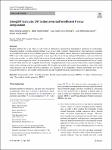Item Infomation
Full metadata record
| DC Field | Value | Language |
|---|---|---|
| dc.contributor.author | Elena Almaraz, Luengo | - |
| dc.contributor.author | Bittor Alaña, Olivares | - |
| dc.contributor.author | Luis Javier García, Villalba | - |
| dc.date.accessioned | 2023-04-10T09:50:27Z | - |
| dc.date.available | 2023-04-10T09:50:27Z | - |
| dc.date.issued | 2023 | - |
| dc.identifier.govdoc | https://link.springer.com/article/10.1007/s13389-023-00313-5 | - |
| dc.identifier.uri | https://dlib.phenikaa-uni.edu.vn/handle/PNK/7727 | - |
| dc.description | CC BY | vi |
| dc.description.abstract | Random numbers play a key role in a wide variety of applications, ranging from mathematical simulation to cryptography. Generating random or pseudo-random numbers is not an easy task, especially when hardware, time and energy constraints are considered. In order to assess whether generators behave in a random fashion, there are several statistical test batteries. ENT is one of the simplest and most popular, at least in part due to its efficacy and speed. Nonetheless, only one of the tests of this suite provides a p value, which is the most useful and standard way to determine whether the randomness hypothesis holds, for a certain significance level. As a consequence of this, rather arbitrary and at times misleading bounds are set in order to decide which intervals are acceptable for its results. | vi |
| dc.language.iso | en | vi |
| dc.publisher | Springer | vi |
| dc.subject | ENT | vi |
| dc.subject | Random numbers | vi |
| dc.title | StringENT test suite ENT battery revisited for efficient P value computation | vi |
| dc.type | Book | vi |
| Appears in Collections | ||
| OER - Công nghệ thông tin | ||
Files in This Item:

